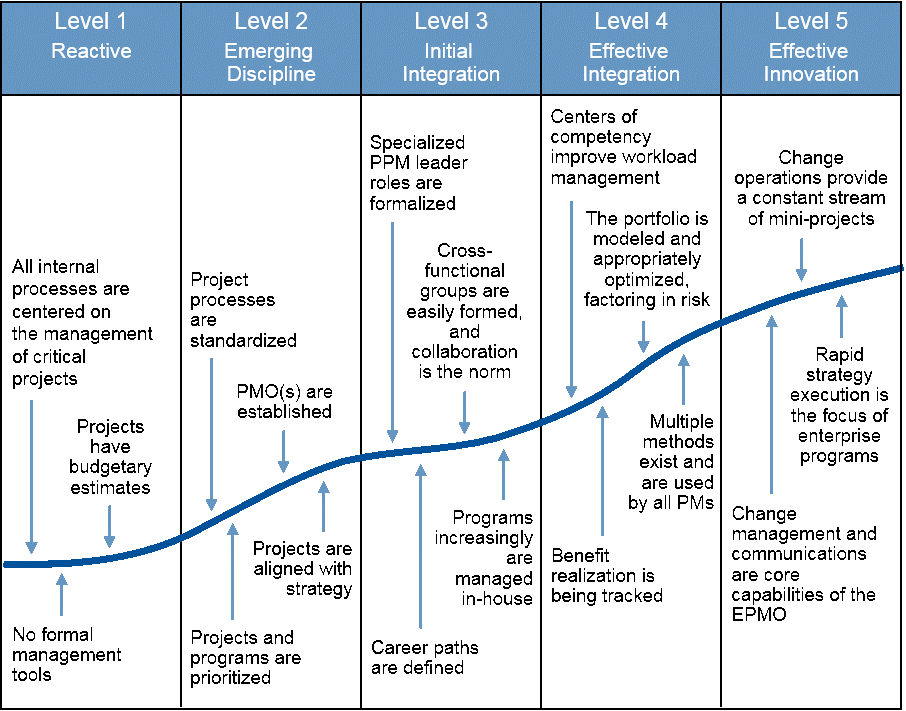PMO Maturity Assessment
Author: Tony de Freitas | 6 min read | August 17, 2017
If you are involved in project management, you may have heard about “standing up a PMO” or “maturing a PMO.” What is a “PMO” and what does it mean to “stand up” or “mature” a PMO?
A PMO is a Project Management Office. The term goes back to the 1950s when the techniques of modern project management were developed through tracking massive government infrastructure projects. A project management office is a project management knowledge repository and management structure that standardizes project governance processes. The PMO went digital with computer technology, where it has been adopted by the agile software development movement for driving and tracking the progress of a portfolio of development projects.
To “stand up” a PMO means to establish a project management system. A “mature PMO” results from years of revising templates and processes, testing and tweaking. Typically, a mature PMO has developed from being just a repository of process to being a driver of process — attached to enterprise strategy and helping to align processes with that strategy.
Datavail has just released a white paper entitled, Standing Up a Project Management Office (PMO), which examines what a PMO does, the communication tools a PMO uses to expedite success, and the phases of development of a PMO system. This post will look at what it means to mature a PMO.
Establishing a Mission for the PMO
When a PMO is stood up, it’s attached to a mission for the organization. For example, a PMO can be started to organize all the supporting documentation related to a specific portfolio, setting standards. The goal is for anyone on the team to be able to quickly locate the latest version of any document used by the team and to be able to access a history of revisions to that document.
With some adjustment to the mission over time, the PMO can be broadened, for example, to include a variety of assets, not just documents. Images, video, audio, applications, code can all be part of a maturing PMO that is growing to encompass revision tracking for all the assets of the organization.
“The PMO must be agile enough to shift the operational focus in a relatively short timeframe. Best practices suggest revisiting the overall PMO mission annually. For rapidly growing companies, a quarterly assessment is recommended if there are significant organizational changes.” — Standing Up a Project Management Office (PMO)
With the mission of the PMO established, different flavors of PMO can be selected. A Supportive PMO functions as a repository of process documentation. A Controlling PMO includes some measure of feedback, such as thresholds that must be met in order to satisfy PMO-programmed standards. A Directive PMO is one that manages the process of process creation by dictating deadlines, approval loops, and other processes. Directive PMOs are able to automate significant portions of process development.
Maturing a PMO
Maturing a PMO is the process of moving the PMO through stages from a focus on operational efficiency to a focus on strategic alignment. A mature PMO does not just follow behind management to record their decision-making processes. A mature PMO drives quality decision-making by continuously assessing contributions and holding them up to standards that are revised and improved on a regular basis. A mature PMO results in quality, consistency and punctuality.
“A PMO matures by enhancement of the current template repository, training, lessons learned, and best practices. These maturity efforts are successful to provide consistent project management support and services such as documentation thoroughness, look and feel, and value across a large agency.” — Standing Up a Project Management Office (PMO)
Below is Gartner’s “PPM Maturity Model,” showing the maturation of the PMO over time, as it can be applied to any business function. The first level (Reactive) consists of little more than a budget, facilitating planning and measurement leading to better planning. At the second level — Emerging Discipline — processes are standardized and a PMO is stood up for prioritizing and tracking processes.
With alignment of the PMO to the organization’s strategy, the PMO enters level three, Initial Integration, where it is mapped to job descriptions and opened to groups outside of finance and IT. The PMO extends its reach to the C-Suite of executives and across all the disciplines in the organization to become the container of teamwork. At level four of maturity, the organization begins tracking and reporting on the benefits of the PMO and the rate of return of various processes.
“Successful PMOs are constantly being challenged to find the best way to ensure that their practices continuously fit organizational needs.” — PMO Maturity Assessment Model
At level five, the PMO is driving the teams that support it, issuing communications, measuring progress, riding herd on deadlines, managing approvals, and assessing results. It is able to break projects down into mini-projects to hasten completion. It is capable of rapidly executing strategy simply by meeting threshold triggers.

Source: “ITScore Overview for Program and Portfolio Management,” Gartner. Used under Fair Use — Commentary.
While there are many different variations on the marketplace to assist with measuring a PMOs maturity, the common core dimensions and five progressive levels outlined by Gartner’s PPM Maturity Model (see chart above) captures a typical path for PMOs along maturity, as it can be applied to any business function. After standing up the Datavail PMO, we perform an annual assessment to ensure the PMO is continually maturing.
Conclusion
“It can easily take two to three years for a PMO to build a track record of delivery performance,” writes Mbula Schoen in Seven Best Practices for a Highly Effective PMO, (Gartner). “PMO leaders can fast forward that process by identifying easy wins and improving the delivery early for a few highly visible projects. This is critical to demonstrate value and earn credibility,” Schoen writes.
Datavail is a specialized IT services company focused on Data Management with solutions in BI/DW, analytics, database administration, custom application development, and enterprise applications. We provide both professional and managed services delivered via our global delivery model, focused on Microsoft, Oracle, and other leading technologies.
